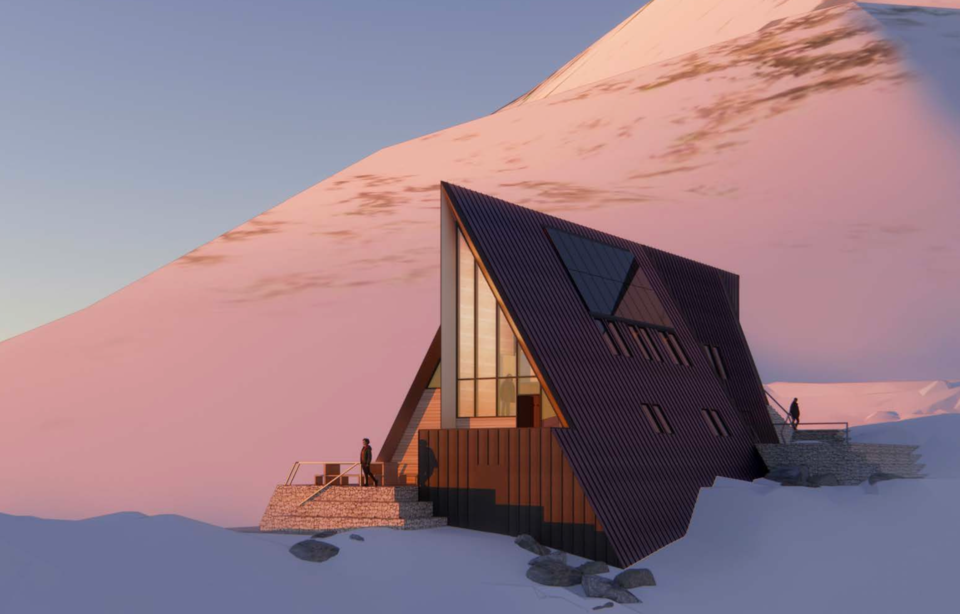The Spearhead Huts Society (SHS) has been busy improving the Kees and Claire Memorial Hut (K+C), and is now embarking on a fundraising initiative for its next destination: the Macbeth Hut.
SHS imagines mountains for backcountry touring and hiking in the Spearhead Range. Built in 2021, K+C is above Russet Lake in Garibaldi Provincial Park and can be visited for day visits or overnight stays at the 38-bunk facility. The next step is the Macbeth Hut, about half-way through the traverse on Mount Macbeth. Construction will likely begin summer 2025. The final piece, the Pattison Hut, is a future project located close to Mount Pattison’s summit on the north end of the range, towards Blackcomb Mountain.
This year, SHS completed solar power installation on the south wall of K+C, which will greatly reduce the propane-use at the hut. Jayson Faulkner, a serving director and the founding chair of SHS, chatted with Pique about the finishing touches on the first of three huts.
“The solar array does a really good job of keeping the batteries topped up and keeping them as much as possible, obviously less in the wintertime, but in the summertime, it keeps some amperage going into the batteries, so the generator doesn't have to work as hard or as long a period using propane,” he said.
Another upgrade which changes the game is internet access through Starlink, added last spring. The reason for an internet connection is for operations and safety. The SHS can remotely monitor hut infrastructure through WiFi, and people have access to necessary information for backcountry touring.
“People can get updated weather. They can do their own route-planning. They can communicate with family and friends about how their trip's going, all those kinds of things,” Faulkner said. “I think a fundamental value is responsibility and self-sufficiency in the backcountry. You should be responsible for your own decisions, and you should be responsible for your own information.”
When booking, visitors are now designated beds, which removes the first-come first-served approach that could lead to conflict.
Water access at K+C
Previously, hut users had to hike down to Russet Lake in the summer, which was a workout. In winter, they melted snow using propane, an unsustainable and energy-intensive solution. Building a pump and water line to the hut was not going to be easy or cheap, nor would it preserve the rugged aesthetic of the land that people work hard to access and appreciate. Instead, SHS decided to drill for a water source close to the hut.
Faulkner said SHS gained approval from BC Parks and flew in equipment and staff for the project, and while a hydrologist was confident there would be access, Faulkner said there was a slim chance it would all be for naught.
“It's really a scary thing to have to do, because you don't know the ground you're going to hit," he said. "Are you going to be drilling through bedrock the whole way, or are you going to run into really awful glacial till, or is it going to be really weird gravel? All those different compositions can have profound and different impacts on the cost of drilling.”
Their first drill came up dry, and so they flew in a second, deeper drill. At 300 feet down, the team struck liquid gold at last, but the winter storm season was approaching and work is on pause again until the spring.
“As soon as we clear the snow away in the late spring, we'll be trying to get connected for the summertime. And then going forward, we don't have to worry about lines freezing. It'll come right out of the ground, basically right underneath the hut,” Faulkner said.
Fundraising for Macbeth Hut
To create the next hut in the Spearhead Traverse, SHS wants to raise $5 million. They have already secured $1.5 million from donations, but to reach the dream and reduce ever-increasing costs for construction, Faulkner said the earlier they reach the fundraising goal, the better.
Design costs are the smallest budget item at $300,000, prefabrication of materials is $1,250,000 and on-site construction at the remote location is $3,500,000, .
Faulkner said all-in costs for K+C ran about $3.5 million. The site is less remote than Macbeth and had a sizeable number of volunteers.
“Fast forward a number of years, those costs are through the roof. So even though the Macbeth is a much simpler design than Kees and Claire and it's about half the size, it is quite a bit more remote. Our estimate on helicopter costs alone is going to be over a million dollars,” he said. For comparison, Faulkner said helicopter costs for K+C were about $400,000.
While the costs may be high, the rewards for experienced backcountry experts are, too. Faulkner described the setting as “truly high alpine,” with views of Fitzsimmons Glacier. The hut will also have less capacity for groups, with capacity for 24 people, because fewer outdoor enthusiasts are skilled enough to make the trek in winter.
“The Macbeth Hut, you've got to travel through some not insignificant, complex terrain," he said. "It’s higher than Kees and Claire Hut, it’s much more complicated to get to when the snow conditions aren't perfect or the weather conditions aren't perfect.”
Another important note on associated building costs is labour. Because of the remote nature, they won’t be able to rely on volunteers the same way they did for K+C.
“Because of the very technical location and nature of the hut, it’s very difficult to integrate a large volunteer workforce into the building process,” Faulkner said.
The construction window is smaller, and so the builders must be more skilled and efficient than what is expected from volunteers.
To donate to the backcountry cause that people will enjoy for generations,



